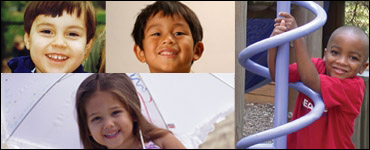CDC Features
Current Features
Autism Research

SEED stands for the Study to Explore Early Development. It is a 5-year, multi-site collaborative study that will help identify what might put children at risk for autism spectrum disorders (ASDs) and other developmental disabilities. It is being conducted by six study sites and a data coordinating center called the Centers for Autism and Developmental Disabilities Research and Epidemiology (CADDRE) Network.
SEED will:
• Be the largest collaborative scientific study to date of the causes of autism. It will include about 2,700 children, 2 through 5 years of age, as well as their parents.
• Include diverse groups from six areas across the county. This will give a more representative sample of all children with autism spectrum disorders in the United States.
• Use standard clinical procedures to classify children with and those without autism spectrum disorders.
• Give information on the many things that could lead to autism.
SEED will look at risk factors for autism spectrum disorders by:
• Talking with mothers about pregnancy-related issues.
• Looking at the medical records of the mother and child.
• Asking the parents to fill out questionnaires at home.
• Taking cheek swabs from the mother, father, and child.
• Doing a developmental and physical evaluation of the child.
• Taking a small sample of blood from the mother, father, and child.
A number of factors will be studied for their potential link with autism spectrum disorders. These factors were picked after an in-depth look at existing studies. Each factor was chosen as high priority based on:
• How strongly it seemed to be linked with autism spectrum disorders.
• What new information was needed about it.
• How well it could be looked at using this study’s methods.
When the study is completed, will we know the causes of autism?
It is too soon to speculate on the results of the study. We hope the study will give us a better idea of which of the risk factors that we will be looking at seem to be the most important in causing autism. The causes may be related to genes, the environment, or a relationship between the two – such as if some groups of children with certain genes are more easily harmed by some environmental exposures.
Will this study find a prevention/cure for autism?
It is too soon to speculate on what we might find about the causes of autism. But, we are hopeful that the findings from SEED will help the development of future studies specifically designed to assess treatments among children with autism.
What is the CADDRE Network?

The CADDRE centers and Data Coordinating Center are:
• California CADDRE: Kaiser Permanente Division of Research and the California Department of Health Services
• Colorado CADDRE: Colorado Department of Public Health and Environment and the University of Colorado at Denver and Heath Sciences Center
• Georgia CADDRE: the National Center on Birth Defects and Developmental Disabilities
• Maryland CADDRE: Johns Hopkins University and Kennedy Krieger Institute
• North Carolina CADDRE: University of North Carolina at Chapel Hill
• Pennsylvania CADDRE: University of Pennsylvania School of Nursing and The Children’s Hospital of Pennsylvania
• Data Coordinating Center: Michigan State University
For More Information
Page last updated: March 31, 2008
Content Source: National Center on Birth Defects and Developmental Disabilities
Content owner: National Center for Health Marketing
URL for this page: www.cdc.gov/Features/AutismResearch

